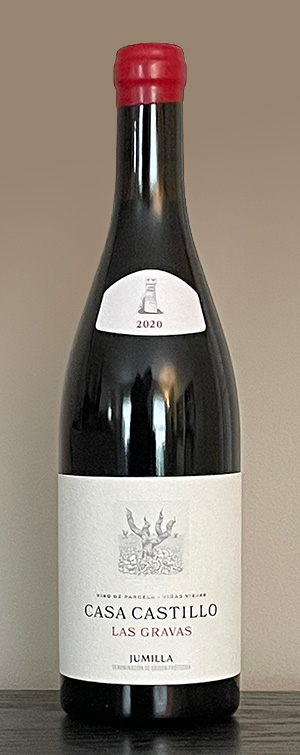
The Jumilla DO [Denomination of Origin] is located in the Levante region of eastern Spain, about 60 miles west of the coastal town of Alicante. With over 100,00 vineyard acres, the area has long been associated with big, high alcohol red wines. The sun-baked landscape sees 300 days of sunshine per year and a low amount of rainfall. But the soils are very good: deep, not very compact, and with great water retention potential.
Since 1991 José María Vicente has been the third-generation owner and operator of the Casa Castillo winery. When his grandfather bought the estate in 1941, situated on the slopes of the Sierra del Molar, the property had an existing winery, a cellar built by Frenchmen fleeing the phylloxera plague in 1870, and a few scattered vineyards.
Originally Casa Castillo was a farm growing wild rosemary, and became an estate producing rather ordinary grapes for local wineries. On his first visit to France, including the whole area of the southern Rhone, Vicente was surprised to see that Monastrell, called Mourvedre there, was considered a very noble variety with great aging potential. This led him to reconsider the supposed “improving varieties” that he was planning on planting to help give a supposed complexity to the Monastrell at Casa Castillo, and instead focus entirely on the study and development of that varietal as the true protagonist of his wines.


José María and his father, Nemesio, replanted the whole property with native grape varietals in 1985, primarily Monastrell of course. Their low density bush vines give tiny yields in the arid conditions. All grapes are hand-harvested, sorted, and fermented in stainless steel or concrete. Depending on the specific wine, ageing is in concrete; foudres (large wooden vats, popular in France’s Rhône Valley, significantly larger than typical oak barrels, often with the capacity to hold more than a thousand liters of wine); and 600L French oak demi-muids, also typically used in the Rhône Valley.

Asked what Jumilla, Monastrell, and dry land means to him, Vicente replied, “We have always thought that the biggest enemy of Monastrell is water, so for us irrigation has never been an obsession. And we have seen many families go broke looking for water, digging wells or changing the whole system to be able to irrigate. Jumilla is a hard and semi-arid area, Dry farming is the most logical and respectful system for vineyard cultivation because it naturally produces concentrated, ripe grapes with a high alcohol content. These are the things that define Jumilla wine, the Mediterranean wine.”

Vicente has abandoned the obsession with color and concentration typical of Jumilla producers to now work in search of a better balance. He has done away with the belief that “more is better” in favor of all the components of a wine being in harmony. Because he has developed a close relationship with the vineyards, his Monastrell is able to more clearly represent the landscape where the ungrafted vines are planted. Finesse, elegance, smoothness, and a refreshing drink are part of the vocabulary he uses to define Casa Castillo wines.
“The family is where it started. The land is the guide. Wine is my destiny,” declares Vicente, a self-taught winemaker.
Casa Castillo Las Gravas 2020
Grapes for this wine came from Las Gravas vineyard (gravel in Spanish),
named after the 30-inch deep stony topsoil on a base of clay and limestone.
Monastrell, Syrah, and Garnacha are all grown on this site. The viticulture was non-certified organic, and the harvesting was by hand. The grapes were foot-trodden, and fermented with a high proportion of whole bunches
in small underground stone tanks. The wine was transferred to 500 liter French oak barrels, of which 20% were new, where malolactic fermentation took place. The wine was then aged for 18 months. The cuvees were
blended after aging, and then bottled unfiltered.
This wine, composed of 92% Monastrell and 8% Garnacha, is a medium dark purple, and transparent enough to see the top of the stem attached to the bowl of the glass. It is richly aromatic, featuring roasted plum and dark berries. Then on the palate come black cherries, cocoa, black currant, violet, black pepper, and just a hint of bitterness. There are polished tannins, and the finish is luxuriously long. ABV is 14.5%.
Top of page: https://winervana.com/blog/
